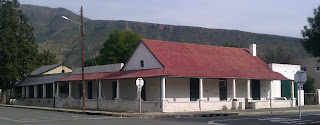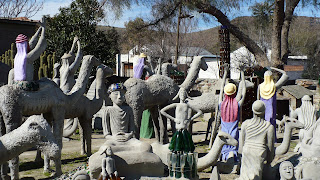

If dry and dusty describes this former Rhenish mission station during the cool winter, then hell knows what it’s like at the height of summer. For a particularly modest sum we rented a substantial 3 bedroom house for the night – Die Bankhuis, built in 1913 – along with its creaky wooden floors, enormous old fashioned bathtub and generous stoep. The landlady looked worn out and explained that the village residents were still recovering from a festival a week earlier. We figured that if things move slower in Williston than Jo’burg then maybe people take longer to recover from their hangovers too.
.jpg)
We think she pretended not to know about it (and indeed there are plenty of Afrikaners embarrassed by this sector of their brethren), though we couldn’t say for sure. Perhaps she was grappling with how on earth to explain to us that as a multiracial pair, we wouldn’t be welcome there. Either way, she returned later on to say that she had gleaned some Orania information from her female relative in the kitchen. In Orania, she declared, there was a giant koeksister monument to visit. J. and I looked at each other in amused disbelief. Was she for real? A colossal history of proud self-determination, racism, self-reliance (selfwerksaamheid) and ethnic defiance, an African place where no black people are seen, all subsumed to South Africa’s syrup-sodden national dessert delicacy?
Later, however, we realized that The Koeksister (now with capitals, note) was our green card to Orania. Perhaps the waitress was actually being uber-strategic. You see, we needed a reason to go in. The signs on both sides of the road state that Orania is private property. So we stopped at the garage and asked a youth with a thick accent for directions to The Koeksister. He seemed to think the request reasonable enough, though an older tannie with a dried-peach face (sucking on a lollipop, nogal) pottered over to us with curious suspicion and asked what we were looking for.
The settlement itself is
small, apparently some 300+ families, probably reminiscent of a lower middle or
working class neighbourhood in the rural United States. Small pre-fab houses with caravans or bakkies outside. Neat roads and verges, and a billboard map at the entrance. Orania has its own credit union and even its own currency, the Ora. Their mayor is the son-in-law of former apartheid Prime Minister Verwoerd. All jobs, from management to manual labour, are filled by Afrikaners only. Apparently parties are not allowed, but they are progressive environmentalists, and we saw a straw-bale house from the road.

It was eerily quiet that Sunday afternoon. Do people just sleep after church? Not even the smell of a braai. (Are braais categorized as parties?) We soon found the ‘giant’ Koeksister, which turned out to be disappointingly small. But it was at the foot of a hill where the metal busts of five unnamed but easily recognisable fathers of Afrikaner nationalism stand in a semi-circle. Their beady guiding eyes are fixed on the figure of a small but defiant boy rolling up his sleeve to in a gesture of resilience, and perhaps in preparation for combat. Nearby, the Orania flag flies high with its Dutch-origin colours of orange, white and blue. Both of us were nervous to even be there in the first place, let alone to set multiracial foot on an exposed monument hilltop where we’d make an easy target for any half-decent extremist marksman. But J. loudly declared that her ancestors had been there first, so up the hill we went. Definite sighs of relief on the way out.
If Orania wasn’t quite enough for one day, then Taung in the North West province was an additional unexpected eye-opener. During the journey towards Taung, we couldn’t understand why this site of the famous 2.5 million year old Autralopithecus Africanus ‘Taung Child’ hominid discovery in the 1920s, wasn’t mentioned on any road signs. None. Anywhere. We drove through the irrigated lands of Hartswater where olives, pecans and grapes grow in abundance, thanks to a crazy idea that Cecil Rhodes had back in the 1880s about irrigating a semi-desert with hand-built canals using family labour. Just after sunset we finally drove into Taung -- and realized that this was no 3-street village frequented by amateur paleoanthropologists, but rather a sprawling and unlit township featuring one Kentucky Fried Chicken, acres of litter, and rows of small brickface RDP houses. Taung used to be part of Bophuthatswana, the former bantustan ethnic homeland for the Tswana people.
We followed the one and only guesthouse sign that took us winding down increasingly dark and dusty roads. It was the second time we were nervous that day, albeit for different reasons. Needless to say, the guesthouse wasn’t in action that night. After a few wrong turns and managing to avoid the stray dogs and jaywalkers, we found a second guesthouse where the hustling hostess took quick note of our Gauteng car registration and our middle-class-rainbow-nation vibe, and promptly upped her prices for the night despite the broken shower. We didn’t have much choice, but complained to her and amongst ourselves over the course of the next 12 hours. A township layover wasn’t exactly what we’d planned, but we both agreed that a potentially dodgy township was infinitely preferable to a staying any longer with the white extremists in Orania.
The night passed uneventfully and we left early next morning for the disused limestone quarry hominid site, which is about 15 kilometres out of Taung in a rural scrubland setting. And what a remarkable site it is. Beyond the gouged-out quarry pits and the deserted workers’ hostels lies a wide gorge sporting ancient cliffs, dotted with rock pools that nestle amidst a network of underground tunnels and lakes. With the assurances of our guide, I pushed aside my claustrophobia and lowered myself into a body-size hole in the corner of a cliff. Underground it is warm and moist. A series of extraordinary stalactites is revealed, each as thick as a pillar. If you listen carefully, there is a soft but definite drip-drip of water. Apparently all sorts of people of faith (including Muslims and Hindus) come here to pray, make offerings and collect sacred water.
Above ground, a pair of nesting Black Eagles treated us with a magnificent fly-by series, showing off their two-metre wingspan – in fact the best eagle sightings I’ve ever had. They mate for life, unlike most humans. Swallows dart and nest in the cliffs where the limestone-pale is made even whiter with guano. Best of all – camping is free by prior arrangement.
The remainder of the drive back to the city of gold via Potchefstroom is soulless if not depressing. The townships become larger and poorer, sprawling as far as the eye can see, the sight of mine dumps and fancier cars more regular. The odd gumboot is abandoned on the roadside. This is in many ways the landscape of the recent Marikana mine-worker tragedy – the worst state violence seen since apartheid, which took place just 1 hour and 37 minutes in a north-west direction from Jo’burg. It’s timely that a report on South Africa’s rich was just published this past weekend: whilst the Marikana miners are protesting about their 4000 rand (US$ 484) per month salaries, the first half of 2012 saw 640 South Africans buy Porsches in the first half of 2012 (a 17% increase in sales) and 513 buy Jaguars (a 99% increase in sales). From Orania and Taung we learn something about this nation’s origins – but its destination feels most ambiguous right now.
[With thanks to J. for her photo of the Orania boy]

.jpg)












